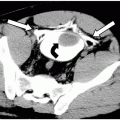Arteriography Primer
Kevin A. Smith
Aortic dissection.
Gastrointestinal bleeding.
Ischemic bowel.
Ischemic extremity.
Penetrating neck trauma.
Peripheral vascular injury with decreased pulses, distal ischemia, bruit, or expanding hematoma.
Renal artery injury.
Subarachnoid hemorrhage to evaluate for cerebral aneurysm.
Thoracic and abdominal aorta injury.
Note.
Because of the increased speed and availability of computed tomographic (CT) scanners, many of these conditions are initially evaluated with CT/computed tomographic angiography (CTA). In many cases, CT scanning can obviate the need for more invasive arteriography or be used to guide subsequent intervention.
Medical history.
Allergies.
Current medications (e.g., Coumadin, heparin, aspirin, sedatives).
Laboratory values: creatinine, hematocrit, platelets, prothrombin time (PT), partial thromboplastin time (PTT).
Pulses: femoral, posterior tibial, and dorsalis pedis bilaterally. If absent, check upper extremities. If necessary, document with portable Doppler.
Informed consent.
Intravenous (IV) access.
Monitors: blood pressure, continuous electrocardiogram (ECG), oxygen saturation.
Oxygen through nasal cannula for oxygen saturation below 95%.
Premedication:
Fentanyl 25-50 µg IV (adult dose) for analgesia
Reversed with naloxone 0.1-0.2 mg increments IV.
Midazolam 0.5-1 mg IV (adult dose) for sedation
Reversed with flumazenil 0.2 mg IV, maximum 1 mg
After assessing hemodynamic and respiratory status, sedation can be continued throughout the procedure as needed in aliquots of 0.5-1 mg midazolam IV and 25-50 µg fentanyl IV.
Preparation.
Make sure distal pulses (posterior tibial and dorsalis pedis) have been documented. Prep both groins. The artery is first localized by palpation for point of maximum impulse. Staying below the inguinal ligament ensures the puncture will be extraperitoneal. The inguinal crease can be an unreliable landmark, particularly in obese patients. In these patients, a fluoroscopic image of the hip can be used to establish landmarks for needle placement. Optimal artery entry site is at level of mid-femoral head. Skin entry should be at inferior margin of the femoral head to allow 45-degree needle entry into artery. A blunt metal instrument can be used to mark the anticipated site of skin entry. Anesthetize the skin and superficial soft tissues with 1-2% lidocaine. Use a number 11 scalpel to make a 5-mm a dermatotomy (skin nick).




